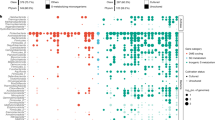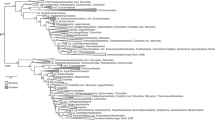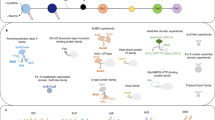Abstract
Archaea are usually minor components of a microbial community and dominated by a large and diverse bacterial population. In contrast, the SM1 Euryarchaeon dominates a sulfidic aquifer by forming subsurface biofilms that contain a very minor bacterial fraction (5%). These unique biofilms are delivered in high biomass to the spring outflow that provides an outstanding window to the subsurface. Despite previous attempts to understand its natural role, the metabolic capacities of the SM1 Euryarchaeon remain mysterious to date. In this study, we focused on the minor bacterial fraction in order to obtain insights into the ecological function of the biofilm. We link phylogenetic diversity information with the spatial distribution of chemical and metabolic compounds by combining three different state-of-the-art methods: PhyloChip G3 DNA microarray technology, fluorescence in situ hybridization (FISH) and synchrotron radiation-based Fourier transform infrared (SR-FTIR) spectromicroscopy. The results of PhyloChip and FISH technologies provide evidence for selective enrichment of sulfate-reducing bacteria, which was confirmed by the detection of bacterial dissimilatory sulfite reductase subunit B (dsrB) genes via quantitative PCR and sequence-based analyses. We further established a differentiation of archaeal and bacterial cells by SR-FTIR based on typical lipid and carbohydrate signatures, which demonstrated a co-localization of organic sulfate, carbonated mineral and bacterial signatures in the biofilm. All these results strongly indicate an involvement of the SM1 euryarchaeal biofilm in the global cycles of sulfur and carbon and support the hypothesis that sulfidic springs are important habitats for Earth’s energy cycles. Moreover, these investigations of a bacterial minority in an Archaea-dominated environment are a remarkable example of the great power of combining highly sensitive microarrays with label-free infrared imaging.
Similar content being viewed by others
Log in or create a free account to read this content
Gain free access to this article, as well as selected content from this journal and more on nature.com
or
References
Adler HH, Kerr PF . (1965). Variations in infrared spectra, molecular symmetry and site symmetry of sulfate minerals. Am Mineralogist 50: 132–147.
Altschul SF, Gish W, Miller W, Myers EW, Lipman DJ . (1990). Basic local alignment search tool. J Mol Biol 215: 403–410.
Amann RI, Binder BJ, Olson RJ, Chisholm SW, Devereux R, Stahl DA . (1990a). Combination of 16S rRNA-targeted oligonucleotide probes with flow cytometry for analyzing mixed microbial populations. Appl Environ Microbiol 56: 1919–1925.
Amann RI, Krumholz L, Stahl DA . (1990b). Fluorescent-oligonucleotide probing of whole cells for determinative, phylogenetic, and environmental studies in microbiology. J Bacteriol 172: 762–770.
Ashelford KE, Chuzhanova NA, Fry JC, Jones AJ, Weightman AJ . (2005). At least 1 in 20 16S rRNA sequence records currently held in public repositories is estimated to contain substantial anomalies. Appl Environ Microbiol 71: 7724–7736.
Asker MMS, Mohamed SF, Ali FM, El-Sayed OH . (2007). Chemical structure and antiviral activity of water-soluble sulfated polysaccharides from Surgassum Iatifolium. J Appl Sci Res 3: 1178–1185.
Beier BD, Quivey RG, Berger AJ . (2010). Identification of different bacterial species in biofilms using confocal Raman microscopy. J Biomed Opt 15: 06001-1–06001-5.
Beniash E, Aizenberg J, Addadi L, Weiner S . (1997). Amorphous calcium carbonate transforms into calcite during sea-urchin larval spicule growth. Proc R Soc Lond B: 461–465.
Budevska BO, Sum ST, Jones TJ . (2003). Application of multivariate curve resolution for analysis of FT-IR microspectroscopic images of in situ plant tissue. Appl Spectrosc 57: 124–131.
Burggraf S, Olsen GJ, Stetter KO, Woese CR . (1992). A phylogenetic analysis of Aquifex pyrophilus. Syst Appl Microbiol 15: 352–356.
Carr GL, Reffner JA, Williams GP . (1995). Performance of an Infrared Microspectrometer at the Nsls. Rev Sci Instrum 66: 1490–1492.
Cole JR, Wang Q, Cardenas E, Fish J, Chai B, Farris RJ et al (2009). The Ribosomal Database Project: improved alignments and new tools for rRNA analysis. Nucleic Acids Res 37: D141–D145.
Dekas AE, Poretsky RS, Orphan VJ . (2009). Deep-sea archaea fix and share nitrogen in methane-consuming microbial consortia. Science 326: 422–426.
DeLong EF . (1998). Everything in moderation: archaea as 'non-extremophiles'. Curr Opin Genet Dev 8: 649–654.
DeSantis TZ, Hugenholtz P, Larsen N, Rojas M, Brodie EL, Keller K et al (2006). Greengenes, a chimera-checked 16S rRNA gene database and workbench compatible with ARB. Appl Environ Microbiol 72: 5069–5072.
Dumas P, Miller LM, Tobin MJ . (2009). Challenges in biology and medicine with synchrotron infrared light. Acta Phys Pol A 115: 446–454.
Elvert M, Suess E, Greinert J, Whiticar MJ . (2000). Archaea mediating anaerobic methane oxidation in deep-sea sediments at cold seeps of the eastern Aleutian subduction zone. Org Geochem 31: 1175–1187.
Engel AS, Lee N, Porter ML, Stern LA, Bennett PC, Wagner M . (2003). Filamentous "Epsilonproteobacteria" dominate microbial mats from sulfidic cave springs. Appl Environ Microbiol 69: 5503–5511.
Engel AS, Porter ML, Stern LA, Quinlan S, Bennett PC . (2004). Bacterial diversity and ecosystem function of filamentous microbial mats from aphotic (cave) sulfidic springs dominated by chemolithoautotrophic "Epsilonproteobacteria". FEMS Microbiol Ecol 51: 31–53.
Frols S, Ajon M, Wagner M, Teichmann D, Zolghadr B, Folea M et al (2008). UV-inducible cellular aggregation of the hyperthermophilic archaeon Sulfolobus solfataricus is mediated by pili formation. Mol Microbiol 70: 938–952.
Geets J, Borremans B, Diels L, Springael D, Vangronsveld J, van der Lelie D et al (2006). DsrB gene-based DGGE for community and diversity surveys of sulfate reducing bacteria. J Microbiol Methods 66: 194–205.
Good IJ . (1953). The population frequencies of species and the estimation of population parameters. Biometrika 40: 237–264.
Goren MB . (1970). Sulfolipid I of Mycobarterium tuberculosis, strain H37Rv II. Structural studies. Biochem Biophys Acta 210: 127–138.
Hall EK, Singer GA, Pölzl M, Hämmerle I, Schwarz C, Daims H et al (2011). Looking inside the box: using Raman microspectroscopy to deconstruct microbial biomass stoichiometry one cell at a time. ISME J 5: 196–208.
Hatzenpichler R, Lebedeva EV, Spieck E, Stoecker K, Richter A, Daims H et al (2008). A moderately thermophilic ammonia-oxidizing crenarchaeote from a hot spring. Proc Natl Acad Sci USA 105: 2134–2139.
Hazen TC, Dubinsky EA, DeSantis TZ, Andersen GL, Piceno YM, Singh N et al (2010). Deep-sea oil plume enriches indigenous oil-degrading bacteria. Science 330: 204–208.
Heidelberg JF, Seshadri R, Haveman SA, Hemme CL, Paulsen IT, Kolonay JF et al (2004). The genome sequence of the anaerobic, sulfate-reducing bacterium Desulfovibrio vulgaris Hildenborough. Nat Biotechnol 22: 554–559.
Henneberger R, Moissl C, Amann T, Rudolph C, Huber R . (2006). New insights into the lifestyle of the cold-loving SM1 euryarchaeon: natural growth as a monospecies biofilm in the subsurface. Appl Environ Microbiol 72: 192–199.
Holman HY, Bechtel HA, Hao Z, Martin MC . (2010). Synchrotron IR spectromicroscopy: chemistry of living cells. Anal Chem 82: 8757–8765.
Holman HY, Wozei E, Lin Z, Comolli LR, Ball DA, Borglin S et al (2009). Real-time molecular monitoring of chemical environment in obligate anaerobes during oxygen adaptive response. Proc Natl Acad Sci USA 106: 12599–12604.
Huang CK, Kerr PF . (1960). Infrared study of the carbonate minerals. The American Mineralogist 45: 311–324.
Huang WE, Stoecker K, Griffiths R, Newbold L, Daims H, Whiteley AS et al (2007). Raman-FISH: combining stable-isotope Raman spectroscopy and fluorescence in situ hybridization for the single cell analysis of identity and function. Environ Microbiol 9: 1878–1889.
Karner MB, DeLong EF, Karl DM . (2001). Archaeal dominance in the mesopelagic zone of the Pacific Ocean. Nature 409: 507–510.
Klappenbach JA, Saxman PR, Cole JR, Schmidt TM . (2001). rrndb: the ribosomal RNA operon copy number database. Nucleic Acids Res 29: 181–184.
Kodama Y, Watanabe K . (2004). Sulfuricurvum kujiense gen. nov., sp. nov., a facultatively anaerobic, chemolithoautotrophic, sulfur-oxidizing bacterium isolated from an underground crude-oil storage cavity. Int J Syst Evol Microbiol 54: 2297–2300.
Lane DJ . (1991). 16S/23S rRNA sequencing. In: Stackebrandt E, Goodfellow M (eds) Nucleic Acid Techniques in Bacterial Systematics. John Wiley & Sons: Chichester, pp. 115–175.
Lapaglia C, Hartzell PL . (1997). Stress-Induced production of biofilm in the hyperthermophile Archaeoglobus fulgidus. Appl Environ Microbiol 63: 3158–3163.
Larkin JM, Strohl WR . (1983). Beggiatoa, Thiothrix, and Thioploca. Annu Rev Microbiol 37: 341–367.
Ledoux RL, White JL . (1964). Infrared study of the OH groups in expanded kaoline. Science 143: 244–246.
Lee ZM, Bussema C, Schmidt TM . (2009). rrnDB: documenting the number of rRNA and tRNA genes in bacteria and archaea. Nucleic Acids Res 37: D489–D493.
Letunic I, Bork P . (2007). Interactive Tree Of Life (iTOL): an online tool for phylogenetic tree display and annotation. Bioinformatics 23: 127–128.
Li M, Canniffe DP, Jackson PJ, Davison PA, FitzGerald S, Dickman MJ et al (2012). Rapid resonance Raman microspectroscopy to probe carbon dioxide fixation by single cells in microbial communities. ISME J 6: 875–885.
Lovley DR, Klug MJ . (1983). Sulfate reducers can outcompete methanogens at freshwater sulfate concentrations. Appl Environ Microbiol 45: 187–192.
Loy A, Lehner A, Lee N, Adamczyk J, Meier H, Ernst J et al (2002). Oligonucleotide microarray for 16S rRNA gene-based detection of all recognized lineages of sulfate-reducing prokaryotes in the environment. Appl Environ Microbiol 68: 5064–5081.
Ludwig W, Strunk O, Westram R, Richter L, Yadhukumar Meier H et al (2004). ARB: a software environment for sequence data. Nucleic Acids Res 32: 1363–1371.
Mancuso CA, Nichols PD, White DC . (1986). A method for the separation and characterization of archaebacterial signature ether lipids. J Lipid Res 27: 49–56.
Manders EEM, Verbeek FJ, Aten JA . (1993). Measurement of co-localization of objects in dual-colour confocal images. J Microsc 169: 375–382.
Mayers GL, Pausada M, Haines TH . (1969). Microbial Sulfolipids. III. The dislfate of (+)-1,14-Docosanediol in Ochromonas danica. Biochemistry 8: 2981–2986.
Moissl C, Rachel R, Briegel A, Engelhardt H, Huber R . (2005). The unique structure of archaeal 'hami', highly complex cell appendages with nano-grappling hooks. Mol Microbiol 56: 361–370.
Moissl C, Rudolph C, Huber R . (2002). Natural communities of novel archaea and bacteria with a string-of-pearls-like morphology: molecular analysis of the bacterial partners. Appl Environ Microbiol 68: 933–937.
Moissl C, Rudolph C, Rachel R, Koch M, Huber R . (2003). In situ growth of the novel SM1 euryarchaeon from a string-of-pearls-like microbial community in its cold biotope, its physical separation and insights into its structure and physiology. Arch Microbiol 180: 211–217.
Moissl-Eichinger C . (2011). Archaea in artificial environments: their presence in global spacecraft clean rooms and impact on planetary protection. ISME J 5: 209–219.
Moissl-Eichinger C, Huber H . (2011). Archaeal symbionts and parasites. Curr Opin Microbiol 14: 364–370.
Nauman D . (2000) Infrared Spectroscopy in Microbiology. John Wiley & Sons, Ltd.: Chichester.
Onstott TC, Colwell FS, Kieft TL, Murdoch L, Phelps TJ . (2009). New horizons for deep subsurface microbiology. Microbe 4: 499–505.
Orphan VJ, House CH, Hinrichs KU, McKeegan KD, DeLong EF . (2001). Methane-consuming archaea revealed by directly coupled isotopic and phylogenetic analysis. Science 293: 484–487.
Palmer AN . (1991). Origin and morphology of limestone caves. Geol Soc Am Bull 103: 1–21.
Parker FS . (1983) Applications of Infrared, Raman, and Resonance Raman Spectroscopy in Biochemistry. Plenum Press: New York, 550pp.
Peak D, Ford RG, Sparks DL . (1999). An in situ ATR-FTIR investigation of sulfate bonding mechanisms on goethite. J Colloid Interface Sci 218: 289–299.
Percival E, Wold JK . (1963). The acid polysaccharide from the green seaweed Ulva lactuca. Part II. The site of the ester sulphate. J Chem Soc, 5459–5468.
Pruesse E, Quast C, Knittel K, Fuchs BM, Ludwig W, Peplies J et al (2007). SILVA: a comprehensive online resource for quality checked and aligned ribosomal RNA sequence data compatible with ARB. Nucleic Acids Res 35: 7188–7196.
Rudolph C . (2003), Molekularbiologische Untersuchungen zur Verbreitung und Physiologie neuartiger, unkultivierter Archaeen in kalten Schwefelquellen. Dissertation, University of Regensburg.
Rudolph C, Moissl C, Henneberger R, Huber R . (2004). Ecology and microbial structures of archaeal/bacterial strings-of-pearls communities and archaeal relatives thriving in cold sulfidic springs. FEMS Microbiol Ecol 50: 1–11.
Rudolph C, Wanner G, Huber R . (2001). Natural communities of novel archaea and bacteria growing in cold sulfurous springs with a string-of-pearls-like morphology. Appl Environ Microbiol 67: 2336–2344.
Schloss PD, Westcott SL, Ryabin T, Hall JR, Hartmann M, Hollister EB et al (2009). Introducing mothur: open-source, platform-independent, community-supported software for describing and comparing microbial communities. Appl Environ Microbiol 75: 7537–7541.
Sinclair RG, McKay AF, Myers GS, Norman Jones R . (1952). The infrared absorption spectra of unsaturaed fatty acids and esters. J Am Chem Soc 74: 2578–2585.
Smith B . (1999) Infrared Spectral Interpretation - A Systematic Approach. CRC Press: Washington, DC.
Sprott GD . (1992). Structures of archaebacterial membrane lipids. J Bioenerg Biomembr 24: 555–566.
Stellmach J . (1984). Fluorescent redox dyes 1. Production of fluorescent formazan by unstimulated and phorbal esteror digitonin-stimulated Ehrlich ascites tumor cells. Histochemistry 80: 137–143.
Stellmach J, Severin E . (1986). A fluorescent redox dye. Influence of several substrates and electron carriers on the tetrazolium salt-formazan reaction of Ehrlich ascites tumor cells. Histochem J 19: 21–26.
Sturt HF, Summons RE, Smith K, Elvert M, Hinrichs KU . (2004). Intact polar membrane lipids in prokaryotes and sediments deciphered by high-performance liquid chromatography/electrospray ionization multistage mass spectrometry--new biomarkers for biogeochemistry and microbial ecology. Rapid Commun Mass Spectrom 18: 617–628.
Takano B . (1985). Geochemical implications of sulfate in sedimentary carbonates. Chem Geol 49: 393–403.
Tamura K, Dudley J, Nei M, Kumar S . (2007). MEGA4: molecular evolutionary genetics analysis (MEGA) software version 4.0. Mol Biol Evol 24: 1596–1599.
Tillett D, Neilan BA . (2000). Xanthogenate nucleic acid isolation from cultured and environmental cyanobacteria. J Phycol 36: 251–258.
Tourna M, Stieglmeier M, Spang A, Konneke M, Schintlmeister A, Urich T et al (2011). Nitrososphaera viennensis, an ammonia oxidizing archaeon from soil. Proc Natl Acad Sci USA 108: 8420–8425.
Tyson GW, Chapman J, Hugenholtz P, Allen EE, Ram RJ, Richardson PM et al (2004). Community structure and metabolism through reconstruction of microbial genomes from the environment. Nature 428: 37–43.
Vaneechoutte M, Rossau R, De Vos P, Gillis M, Janssens D, Paepe N et al (1992). Rapid identification of bacteria of the Comamonadaceae with amplified ribosomal DNA-restriction analysis (ARDRA). FEMS Microbiol Lett 72: 227–233.
Wagner M . (2009). Single-cell ecophysiology of microbes as revealed by raman microspectroscopy or secondary ion mass spectrometry imaging. Annu Rev Microbiol 63: 411–429.
Wagner M, Roger AJ, Flax JL, Brusseau GA, Stahl DA . (1998). Phylogeny of dissimlatory sulfite reductases supports an early origin of sulfate respiration. J Bacteriol 180: 2975–2982.
Walker CB, de la Torre JR, Klotz MG, Urakawa H, Pinel N, Arp DJ et al (2010). Nitrosopumilus maritimus genome reveals unique mechanisms for nitrification and autotrophy in globally distributed marine crenarchaea. Proc Natl Acad Sci USA 107: 8818–8823.
Wallner G, Amann R, Beisker W . (1993). Optimizing fluorescent in situ hybridization with rRNA-targeted oligonucleotide probes for flow cytometric identification of microorganisms. Cytometry 14: 16–143.
White WB . (1974) The Carbonated Minerals. Mineralogical Society: London.
Whittaker P, Mossoba MM, Al-Khaldi S, Fry FS, Dunkel VC, Tall BD et al (2003). Identification of foodborne bacteria by infrared spectroscopy using cellular fatty acid methyl esters. J Microbiol Methods 55: 709–716.
Yoshida N, Hiraishi A . (2004). An improved redox dye-staining method using 5-cyano-2,3-ditoryl tetrazolium chloride for detection of metabolically active bacteria in activated sludge. Microbes Environ 19: 61–70.
Acknowledgements
Technical assistance by Lauren Tom as well as review and discussion provided by Robert Huber and Reinhard Wirth are much appreciated. Work at University of Regensburg was performed under the DFG grant MO19773–1 given to Christine Moissl-Eichinger. Phylogenetic work at Lawrence Berkeley National Laboratory was performed under the auspices of the U.S. Department of Energy under contract no. DE-AC02–05CH11231. The SR-FTIR and associated imaging work were performed under the Berkeley Synchrotron Infrared Structural Biology (BSISB) Program and the Subsurface Science Scientific Focus Area funded by the U.S. Department of Energy, Office of Science and Office of Biological and Environmental Research through contracts DE-AC02–05CH11231. The Advanced Light Source is supported by the Director, Office of Science, Office of Basic Energy Sciences, of the U.S. Department of Energy under contract no. DE-AC02–05CH11231. The authors are grateful to PreSens (Germany, Regensburg) for providing the oxygen dipping probe PSt6 and the Fibox 3, LCD trace. Alexander J Probst was supported by the German National Academic Foundation (Studienstiftung des deutschen Volkes).
Author information
Authors and Affiliations
Corresponding author
Additional information
Supplementary Information accompanies the paper on The ISME Journal website
Supplementary information
Rights and permissions
About this article
Cite this article
Probst, A., Holman, HY., DeSantis, T. et al. Tackling the minority: sulfate-reducing bacteria in an archaea-dominated subsurface biofilm. ISME J 7, 635–651 (2013). https://doi.org/10.1038/ismej.2012.133
Received:
Revised:
Accepted:
Published:
Issue date:
DOI: https://doi.org/10.1038/ismej.2012.133
Keywords
This article is cited by
-
In situ X-ray and IR probes relevant to Earth science at the Advanced Light Source at Lawrence Berkeley Laboratory
Physics and Chemistry of Minerals (2024)
-
The microbiome of Riccia liverworts is an important reservoir for microbial diversity in temporary agricultural crusts
Environmental Microbiome (2023)
-
Taxonomic and functional analyses of intact microbial communities thriving in extreme, astrobiology-relevant, anoxic sites
Microbiome (2021)
-
Lipid analysis of CO2-rich subsurface aquifers suggests an autotrophy-based deep biosphere with lysolipids enriched in CPR bacteria
The ISME Journal (2020)
-
Multi-technique microscopy investigation on bacterial biofilm matrices: a study on Klebsiella pneumoniae clinical strains
Analytical and Bioanalytical Chemistry (2019)



